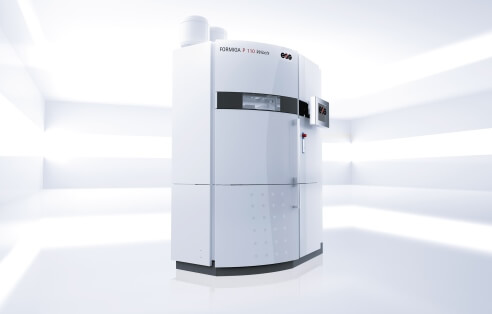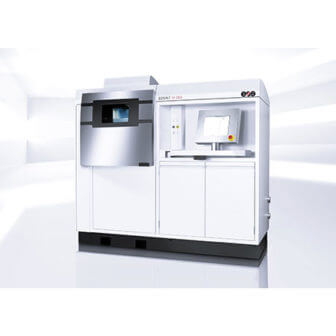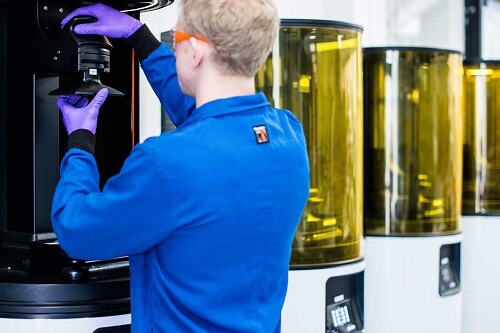How does a 3D printer work?
You want to use 3D printing, but don’t know how 3D printers work? Or maybe you are already using 3D printing but don’t really understand the way these impressive 3D machines work. That is why, today, we chose to focus on these amazing 3D printing systems.

You want to use 3D printing, but don’t know how 3D printers work? Or maybe you are already using 3D printing but don’t really understand the way these impressive 3D machines work. That is why, today, we chose to focus on these amazing 3D printing systems.
How does a 3D printer work? Are there different types of 3D printers? Let’s go deeper into the 3D printing technology!
What is a 3D printer?
At first, 3D printing seem like a little bit of magic, we see that this amazing technology can help to build houses or any objects from our daily life. But how does it work?
First, let’s go back to the basics and see what a 3D printer is. From metal to plastic or even chocolate, additive manufacturing gives life to a lot of different projects. There isn’t just one type of 3D printer, there are a lot of existing machines, and a lot of different printing techniques.
Here is the basic 3D printing process: first, you need to get a 3D file. The 3D design is necessary while starting a 3D printing project, it the digital version of the project that you will 3D print.
Then, you will have to choose the 3D printing technology you need for your project. Each material has its own properties, your choice will totally depend on the nature of your project. Do you need a rapid prototype or an end-use product? Does your object have to be heat resistant, flexible or really resistant to stress? This choice is surely an important step in this process and it will define the quality and the coherence of your project.
After all of this, your 3D design will be sent to a 3D printer, to create a three-dimensional object, with a succession of layers. But, what are the different 3D printers on the market and how do they work?
What can a 3D printer do?
Additive manufacturing can be used by designers, engineers, anyone willing to develop a project and looking for benefits such as innovation, adaptability and scalability with an attractive cost.
For production or rapid prototyping, 3D printers are offering a wide range of possibilities for many industries such as automotive, fashion, medical, or entertainment. Props, jewelry, tools, spare parts, prosthetics… the list of objects that could actually be 3D printed seems to be endless.
Thanks to the variety of materials, the development of high-performance materials, the most demanding industries can now start implementing additive manufacturing.
What are the advantages of 3D printing?
If you are interested in 3D printers and the way they work, you will also have to understand all their advantages. Here are the main benefits of using additive manufacturing:
- Flexibility
3D printing allows more flexibility for your business. When you need a part, you can just 3D print it. If you need to modify a part, you can also 3D print it. With an online 3D printing service such as Sculpteo, you can order the number of parts you need, there is no minimum, from 1 to 10K+ parts you only produce what you need, on-demand.
- Quick iteration
Additive manufacturing is a great solution if you need to speed up your product development. You will get better and more efficient iterations management. Time is money, and money is precious while running a business and developing projects. Saving time and quickening your whole product development cycle is a crucial part of your business.
- Innovation
One of the biggest advantages of 3D printing is the freedom offered by design. You can recreate all your ideas to transform them into actual objects. Even the most complex geometries can be printed. While using 3D printing you will be released from the limitations of traditional manufacturing. Creating a design for a layer-by-layer process such as 3D printing is also a bit different: a 3D design created for injection molding will not be adapted for 3D printing, for example.
- Customization
Mass-customization can be an advantage for numerous industries, from the medical field to the production of consumer goods, and automotive. For example, additive manufacturing allows the creation of made-to-measure prosthetics or tools in the medical industry. But it can also be used to create adapted 3D printed glasses.
- Improvement of the supply-chain
Implementing additive manufacturing in your process is also the perfect solution to rethink your supply-chain and start thinking about the dematerialization of your storage. With 3D printing, there is no need to store your parts, you just can print them when you need them. Indeed, this cutting-edge technology is good for printing low-volumes. It might even be more economical than other traditional manufacturing processes. Once you have your 3D file ready, you just have to 3D print it using an online 3D printing service like Sculpteo.
Plastic 3D printers: From rapid prototyping to production
Selective Laser Sintering (or SLS): This 3D printing technique is perfect to create complex forms or interlocking parts. How does an SLS printer work? This plastic 3D printing technique creates 3D printed objects by sintering the powder layer by layer. The powder bed is preheated, almost at its melting point, and then a laser sinters the powder according to the 3D file. The laser sinters the powder layer by layer, creating a solid object. Polyamide needs to be sintered at a temperature of 160°C to 200°C.

Fused Deposition Modeling (or FDM): This additive manufacturing technique is preferred by hobbyists and in education. Thanks to one or two print heads, the 3D machine allows the deposition of the 3D printing materials. This 3D printer works by the material being melted and extruded through a nozzle to 3D print a cross-section of an object each layer at a time. The most used 3D printing materials with FDM technology are ABS and PLA, a bioplastic. These materials are the standard materials used for this technology.
FDM can be a good solution to develop your own prototypes, as desktop 3D printers are more affordable than industrial 3D printers.
Metal 3D printers: Manufacture your most resistant parts
Direct Metal Laser Sintering or DMLS: 3D printers for the DMLS technology create parts additively by sintering fine metal powder particles, to fuse them together locally. It is quite similar to the SLS process we saw previously, the major difference is the sintering temperature. Indeed, polyamide needs to be sintered at a temperature of 160°C to 200°C, whereas metal melts at a temperature around between 1510°C and 1600°C meaning that a more high-wattage laser is needed to reach that temperature.
A roller will apply a layer of metal powder, then the laser will sinter the powder and the build platform will lower before applying a new layer of powder. The process is repeated until the desired 3D part is created! Once it’s finished, the 3D printed parts need to cool down.

Selective Laser Melting, SLM: This method creates parts additively by fusing metal powder particles together in a full melting process. With this SLM process, like for other additive manufacturing techniques, your metal part will be created layer by layer, according to your 3D model.
The build chamber of the 3D printer is filled with an inert gas (either argon or nitrogen at oxygen levels below 500 parts per million) in order to create the perfect conditions for the melting process. Indeed, unlike DMLS, SLM fully melts the powder, and therefore it needs to reach a higher temperature than this other metal 3D printing technique. This process allows the metal to form a homogeneous block with great resistance.
Binder Jetting: Binder Jetting is an additive manufacturing method that also creates metal parts additively. This process works with a binding agent. This liquid binding agent is deposited on the powder, according to the 3D file you want to have made. The powder is lightly cured for solidification between each layer. When the printing process is complete, the build box is removed from the printer and placed into an oven for curing.
When the process is over, the parts are extracted from the build box and the remaining powder is removed thanks to brushes and air blowers.
Resin 3D printers: Create accurate and detailed 3D printed parts
The DLS technology: The DLS technology developed by Carbon works by projecting a continuous sequence of UV images, generated by a digital light projector, through an oxygen-permeable, UV-transparent window below a liquid resin bath.
The dead zone created above the window maintains a liquid interface below the part. Above the dead zone, the curing part is drawn out of the resin bath. Carbon 3D created two 3D printer machines: the M1 printer and the M2 printer for this technology.

Polyjet 3D printers: PolyJet 3D Printers spray layers of curable liquid photopolymer onto a build tray. During the pre-processing, the software automatically calculates the placement of photopolymers and support material from a 3D CAD file. During the printing, the resin 3D printer jets and instantly UV-cures tiny droplets of liquid photopolymer.
Multicolor 3D printers
Colorjet: One example of multicolor printers is the ZCorp 3D printer. This machine, like all other 3D machines, print out the object layer by layer. A rolling batch leaves a uniform layer of the sandstone-like powder. From there, two printing heads pass over the batch, coloring and adhering the object at the same time. The batch of powder then makes another pass, until the object is completed!
Which 3D printer should you choose?
We hope that this blog post helped you to understand how 3D printers work and understand the different possibilities. There are obviously a lot of choices to 3D print your project, each 3D printing technique and 3D printer has its specificities.
If you are not ready to invest into a 3D printer, using an online 3D printing service such as Sculpteo can help you speed up your prototyping process or your production. Most 3D printers from this article are available to 3D print your project, in our factory! Check out our 3D printing catalog and choose your 3D printing technique! Upload your 3D file on our online 3D printing service and get your instant quote for your project!
Subscribe to our newsletter right here and get all the 3D printing news.